How to connect batteries in series and parallel
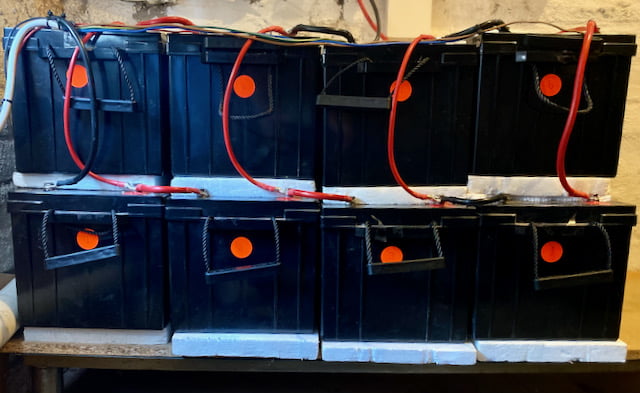
What is a bank of batteries? No, battery banks are not some kind of financial battery establishments. A battery bank is the result of joining two or more batteries together for a single application. What does this accomplish? Well, by connecting batteries, you can increase the voltage (series), amperage (parallel), or both. When you need more power, instead of getting yourself a massive super tanker off an RV battery. For example, you can construct a battery bank using a high-amp AGM Battery for your home solar system or even remote trailer.
The first thing you need to know is that there are two primary ways to successfully connect two or more batteries: The first is via a series and the second is called parallel. Let’s start with the series method as we compare series vs parallel.
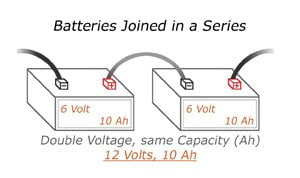
How to wire batteries in series: Connecting batteries in series adds the voltage of the two batteries, but it keeps the same amperage rating (also known as Amp Hours). For example, these two 6-volt batteries joined in series now produce 12 volts, but they still have a total capacity of 10 amps.
To connect batteries in a series, use jumper wire to connect the negative terminal of the first battery to the positive terminal of the second battery. Use another set of cables to connect the open positive and negative terminals to your application.
When connecting batteries: Never cross the remaining open positive and open negative terminals with each other, as this will short circuit the batteries and cause damage or injury.
Be sure the batteries you are connecting have the same voltage and capacity rating. Otherwise, you may end up with charging problems, and shortened battery life.
ChillNet Wisdom
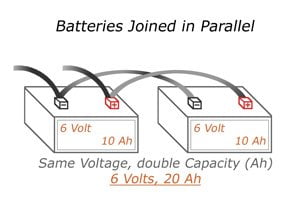
How to wire batteries in parallel: The other type of connection is parallel. Parallel connections will increase your current rating, but the voltage will stay the same. In the “Parallel” diagram, we’re back to 6 volts, but the amps increase to 20 AH. It’s important to note that because the amperage of the batteries increased, you may need a heavier-duty cable to keep the cables from burning out.
To join batteries in parallel, use a jumper wire to connect both the positive terminals, and another jumper wire to connect both the negative terminals of both batteries to each other. Negative to negative and positive too positive. You CAN connect your load to ONE of the batteries, and it will drain both equally. However, the preferred method for keeping the batteries equalised is to connect to the positive at one end of the battery pack, and the negative at the other end of the pack.
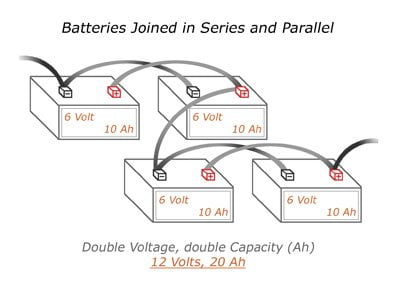
It is also possible to connect batteries in series and parallel configuration. This may sound confusing, but we will explain below. This is the way you can increase your voltage output and Amp/Hour rating. To do this successfully, you need at least 4 batteries.
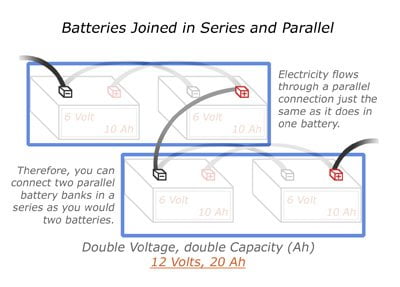
If you have two sets of batteries already connected in parallel, you can join them together to form a series. In the diagram above, we have a battery bank that produces 12 volts and has 20 amp hours.
Don’t get lost now. Remember, electricity flows through a parallel connection just the same as it does in a single battery. It can’t tell the difference. Therefore, you can connect two parallel connections in a series as you would two batteries. Only one cable is needed; a bridge between a positive terminal from one parallel bank to a negative terminal from the other parallel bank.
It’s alright if a terminal has more than one cable connected to it. It’s necessary to successfully construct these kinds of battery banks.
In theory, you can connect as many batteries together as you want. But when you start to construct a tangled mess of batteries and cables, it can be very confusing, and confusion can be dangerous. Keep in mind the requirements for your application, and stick to them. Also, use batteries of the same capabilities. Avoid mixing and matching battery sizes wherever possible.
Always remember to be safe, and keep track of your connections. If it helps, make a diagram of your battery banks before attempting to construct them. Good luck!
Quick Vocabulary Reference:
AMP Hour is a unit of measure for a battery’s electrical storage capacity. The standard rating is an amp rating taken for 20 Hours.
Voltage represents the pressure of electricity. Some applications require more “pressure,” meaning higher voltage.






